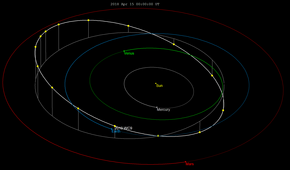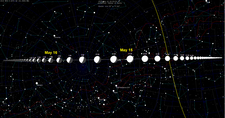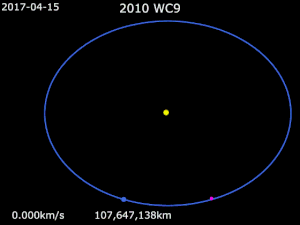 Orbit of 2010 WC9 with positions before 2018 flyby Orbit of 2010 WC9 with positions before 2018 flyby | |
| Discovery | |
|---|---|
| Discovered by | Catalina Sky Srvy. |
| Discovery site | Catalina Stn. (first observed only) |
| Discovery date | 30 November 2010 |
| Designations | |
| MPC designation | 2010 WC9 |
| Alternative designations | ZJ99C60 |
| Minor planet category | |
| Orbital characteristics | |
| Epoch 23 March 2018 (JD 2458200.5) | |
| Uncertainty parameter 0 | |
| Observation arc | 7.45 yr (2,721 d) |
| Aphelion | 1.3797 AU |
| Perihelion | 0.7784 AU |
| Semi-major axis | 1.0791 AU |
| Eccentricity | 0.2786 |
| Orbital period (sidereal) | 1.12 yr (409 d) |
| Mean anomaly | 251.06° |
| Mean motion | 0° 52 45.48 / day |
| Inclination | 17.994° |
| Longitude of ascending node | 54.655° |
| Argument of perihelion | 273.53° |
| Earth MOID | 0.00138 AU (0.5454 LD) |
| Venus MOID | 0.158 AU (23,600,000 km) |
| Physical characteristics | |
| Mean diameter | |
| Synodic rotation period | 8–20 minutes |
| Absolute magnitude (H) | 23.5 |
2010 WC9, unofficially designated ZJ99C60, is a sub-kilometer near-Earth asteroid of the Apollo group, approximately 100 meters (330 feet) in diameter. First observed for eleven days by the Catalina Sky Survey in 2010, the asteroid was recovered in May 2018 during its sub-lunar close encounter with Earth.
First observation and recovery
2010 WC9 was first observed by astronomers with the Catalina Sky Survey on 30 November 2010 with a 1-day observation arc and was observed through 10 December 2010. By 10 December 2010, the asteroid was more than 24 million kilometers from Earth at apparent magnitude 21.8 and was becoming too faint to be practical to track.
The preliminary 10-day observation arc generated a line of variation roughly 15 million km long for May 2018 that did not intersect Earth's orbit and thus was not a 2018 impact threat. The 10-day observation arc showed the asteroid would pass about 0.026 AU (3,900,000 km; 2,400,000 mi) from Earth around late 14 May 2018. The asteroid was recovered on 8 May 2018 when it was 8 million kilometers from Earth and given the temporary NEOCP designation ZJ99C60. It was removed from the Sentry Risk Table on 10 May 2018 and is not an impact threat for the next 100 years or more. The asteroid now has a secure 7-year observation arc.
Orbit and classification
2010 WC9 is an Apollo asteroid, the largest dynamical group of near-Earth objects with nearly 10,000 known members. It orbits the Sun at a distance of 0.78–1.4 AU once every 13 months (409 days; semi-major axis of 1.08 AU). Its orbit has an eccentricity of 0.28 and an inclination of 18° with respect to the ecliptic.
Using an epoch of 23 March 2018, the object had a minimum orbital intersection distance with Earth of 206,000 km (0.00138 AU), or 0.55 lunar distances (LD).
2018 approach
On 15 May 2018, 22:05 UT, the asteroid approached Earth at just over 0.5 LD, the closest approach of this asteroid in nearly 300 years. It was expected to reach apparent magnitude +11 at closest approach, bright enough to be seen in a small telescope if you have a custom ephemeris for your location. At closest approach, it was best seen from the Southern hemisphere such as South Africa and southern South America. The asteroid passed Earth going 12.81 km/s (28,700 mph).
This was the third closest approach ever observed by an asteroid with absolute magnitude (H) brighter than 24.

 Flyby in 2018: geocentric trajectory in the sky (top) and flyby from north to south, shown with hourly motion (bottom)
Animation of 2010 WC9's orbit
Flyby in 2018: geocentric trajectory in the sky (top) and flyby from north to south, shown with hourly motion (bottom)
Animation of 2010 WC9's orbit Around the Sun
Around the Sun Around the Earth 2010 WC9 · Sun · Earth · Moon
History of closest approaches of large near-Earth objects since 1914
Around the Earth 2010 WC9 · Sun · Earth · Moon
History of closest approaches of large near-Earth objects since 1914(less than H 24 and 1 LD)
| NEO | Date | Approach distance in lunar distances | Abs. mag (H) |
Diameter (m) |
Ref | ||
|---|---|---|---|---|---|---|---|
| Nominal | Minimum | Maximum | |||||
| (152680) 1998 KJ9 | 1914-12-31 | 0.606 | 0.604 | 0.608 | 19.4 | 279–900 | data |
| (458732) 2011 MD5 | 1918-09-17 | 0.911 | 0.909 | 0.913 | 17.9 | 556–1795 | data |
| (163132) 2002 CU11 | 1925-08-30 | 0.903 | 0.901 | 0.905 | 18.5 | 443–477 | data |
| 2010 VB1 | 1936-01-06 | 0.553 | 0.553 | 0.553 | 23.2 | 48–156 | data |
| 2002 JE9 | 1971-04-11 | 0.616 | 0.587 | 0.651 | 21.2 | 122–393 | data |
| 2013 UG1 | 1976-10-17 | 0.854 | 0.853 | 0.855 | 22.3 | 73–237 | data |
| 2012 TY52 | 1982-11-04 | 0.818 | 0.813 | 0.822 | 21.4 | 111–358 | data |
| 2012 UE34 | 1991-04-08 | 0.847 | 0.676 | 1.027 | 23.3 | 46–149 | data |
| 2017 VW13 | 2001-11-08 | 0.373 | 0.316 | 3.236 | 20.7 | 153–494 | data |
| 2002 MN | 2002-06-14 | 0.312 | 0.312 | 0.312 | 23.6 | 40–130 | data |
| (308635) 2005 YU55 | 2011-11-08 | 0.845 | 0.845 | 0.845 | 21.9 | 320–400 | data |
| 2011 XC2 | 2011-12-03 | 0.904 | 0.901 | 0.907 | 23.2 | 48–156 | data |
| 2018 AH | 2018-01-02 | 0.773 | 0.772 | 0.773 | 22.5 | 67–216 | data |
| 2018 GE3 | 2018-04-15 | 0.502 | 0.501 | 0.503 | 23.7 | 35–135 | data |
| 2010 WC9 | 2018-05-15 | 0.528 | 0.528 | 0.528 | 23.5 | 42–136 | data |
| (153814) 2001 WN5 | 2028-06-26 | 0.647 | 0.647 | 0.647 | 18.2 | 921–943 | data |
| 99942 Apophis | 2029-04-13 | 0.0989 | 0.0989 | 0.0989 | 19.7 | 310–340 | data |
| 2012 UE34 | 2041-04-08 | 0.283 | 0.274 | 0.354 | 23.3 | 46–149 | data |
| 2015 XJ351 | 2047-06-06 | 0.789 | 0.251 | 38.135 | 22.4 | 70–226 | data |
| 2007 TV18 | 2058-09-22 | 0.918 | 0.917 | 0.919 | 23.8 | 37–119 | data |
| 2005 WY55 | 2065-05-28 | 0.865 | 0.856 | 0.874 | 20.7 | 153–494 | data |
| (308635) 2005 YU55 | 2075-11-08 | 0.592 | 0.499 | 0.752 | 21.9 | 320–400 | data |
| (456938) 2007 YV56 | 2101-01-02 | 0.621 | 0.615 | 0.628 | 21.0 | 133–431 | data |
| 2007 UW1 | 2129-10-19 | 0.239 | 0.155 | 0.381 | 22.7 | 61–197 | data |
| 101955 Bennu | 2135-09-25 | 0.531 | 0.507 | 0.555 | 20.19 | 472–512 | data |
| (153201) 2000 WO107 | 2140-12-01 | 0.634 | 0.631 | 0.637 | 19.3 | 427–593 | data |
| 2009 DO111 | 2146-03-23 | 0.896 | 0.744 | 1.288 | 22.8 | 58–188 | data |
| (85640) 1998 OX4 | 2148-01-22 | 0.771 | 0.770 | 0.771 | 21.1 | 127–411 | data |
| 2011 LT17 | 2156-12-16 | 0.998 | 0.955 | 1.215 | 21.6 | 101–327 | data |
| This list includes near-Earth approaches of less than 1 lunar distances (LD) of objects with H brighter than 24. Nominal geocentric distance from the center of Earth to the center of the object (Earth has a radius of approximately 6,400 km). Diameter: estimated, theoretical mean-diameter based on H and albedo range between 0.05 and 0.25. Reference: data source from the JPL SBDB, with AU converted into LD (1 AU≈390 LD) Color codes: unobserved at close approach observed during close approach upcoming approaches Note: All close approaches between 1900 and 2200 are listed (with H<24 at less than 1 LD). Objects not observed during the approach, and simply estimated to have approached on this date, are colored grey. Generically estimated asteroid diameters are given in italics. | |||||||
Physical characteristics
Diameter
As the asteroid has not been directly resolved by telescope, its diameter can only be estimated based on the distance and brightness. Based on a generic magnitude-to-diameter conversion, it is estimated to measure between 60 and 130 meters in diameter, for an absolute magnitude of 23.5, and an assumed albedo of 0.04–0.20.
Numbering and naming
As of 2018, this minor planet has neither been numbered nor named by the Minor Planet Center.
See also
References
- ^ "2010 WC9". Minor Planet Center. Retrieved 11 May 2018.
- ^ ""Pseudo-MPEC" for ZJ99C60". projectpluto.com. 10 May 2018. Archived from the original on 12 May 2018. Retrieved 14 May 2018.
- ^ Irizarry, Eddie (12 May 2018). ""Lost" asteroid to pass closely May 15". earthsky.org. Retrieved 12 May 2018.
- ^ "JPL Small-Body Database Browser: (2010 WC9)" (2018-05-13 last obs.). Jet Propulsion Laboratory. Archived from the original on 10 May 2018. Retrieved 11 May 2018.
- ^ "Asteroid Size Estimator". CNEOS NASA/JPL. Retrieved 14 May 2018.
- ^ "MPEC 2010-X07 : 2010 WC9". IAU Minor Planet Center. 1 December 2010. Retrieved 13 May 2018. (K10W09C)
- "MPC/MPO/MPS Archive: MPS 358671-362682" (PDF). IAU Minor Planet Center. 19 December 2010. Retrieved 13 May 2018. (pg 645)
- Earth Impact Risk Summary: 2010 WC9 (10 day arc; computed on Sep 20, 2015) "2010 WC9 Impact Risk". Archived from the original on 15 December 2016. Retrieved 13 May 2018.
- Removed Objects "Sentry: Earth Impact Monitoring". Archived from the original on 13 May 2018. Retrieved 14 May 2018.
{{cite web}}: CS1 maint: bot: original URL status unknown (link) - "2010WC9 Ephemerides for 15–16 May 2018". NEODyS (Near Earth Objects – Dynamic Site). Retrieved 14 May 2018.
- "Closest Approaches to the Earth by Minor Planets". Minor Planet Center. Retrieved 14 May 2018.
External links
- "Lost" asteroid to pass closely May 15 Eddie Irizarry, 12 May 2018
- Asteroid 2010 WC9 to flyby Earth at 0.53 LD on 15 May
- List Of Apollo Minor Planets (by designation), Minor Planet Center
- 2010 WC9 at NeoDyS-2, Near Earth Objects—Dynamic Site
- 2010 WC9 at ESA–space situational awareness
- 2010 WC9 at the JPL Small-Body Database
| Small Solar System bodies | |||||||
|---|---|---|---|---|---|---|---|
| Minor planets |
| ||||||
| Comets | |||||||
| Other | |||||||

